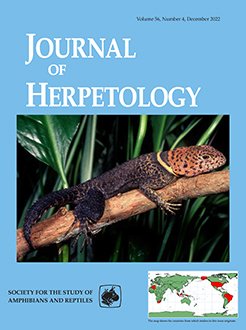Coastal Tailed Frogs (Ascaphus truei) range across the Pacific Northwest from northern California, USA, into British Columbia, Canada, and from sea level to >2,131 m. Previous work has shown a variable larval period but has not clearly separated elevational from latitudinal effects. Therefore, we examined size at beginning of metamorphosis, larval period, individual growth rates, and timing of metamorphosis of A. truei populations along an elevational gradient from 152 to 2,131 m across a small latitudinal range (29 km) to reduce potential latitudinal effects, all within the Klamath Mountains of northern California. We sampled larvae at 15 study sites, of which we used 6 sites as intensive capture–mark–recapture (CMR) locations, and the other 9 for supplemental data on larval period and size at metamorphosis. In CMR sites, we individually marked tadpoles to determine within-season growth rates. We found that the A. truei larval period in these populations ranges from 2 yr in low and middle elevations to ‡3 yr in high-elevation populations. We also found decreased size at beginning of metamorphosis and increased growth rates of tadpoles with increasing elevation. Our high-elevation populations had the longest larval period documented in California. The associations of growth and timing of metamorphosis to elevation in A. truei populations suggest that responses to changing climate may differ across elevations.
How to translate text using browser tools
28 March 2023
Larval Life History of Coastal Tailed Frogs (Ascaphus truei) Across an Elevational Gradient in Northern California: Implications for a Changing Climate
Adrian D. Macedo,
Justin A. Demianew,
Justin M. Garwood,
John O. Reiss
ACCESS THE FULL ARTICLE

Journal of Herpetology
Vol. 57 • No. 1
March 2023
Vol. 57 • No. 1
March 2023




